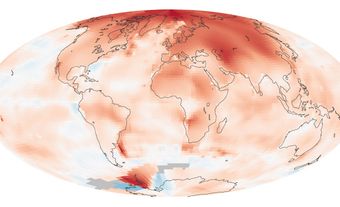The Montreal Protocol on Substances that Deplete the Ozone Layer, known simply as the Montreal Protocol, is an international environmental agreement. It regulates the consumption and production of approximately 100 man-made, ozone-depleting chemicals. The Montreal Protocol is so named because it was initially signed in Montreal on 16 September 1987. To date, the Montreal Protocol is the only United Nations treaty that every country in the world has ratified.

Ozone Depletion
Chemists Mario Molina and F. Sherwood Rowland began studying the impact of chlorofluorocarbons (CFCs) on the planet’s atmosphere while working for the University of California, Irvine, in 1973.
Chlorofluorocarbons are non-toxic, non-flammable chemicals containing atoms of carbon, chlorine and fluorine. They have been used in aerosol sprays, solvents, and refrigerants, among other uses. Though CFCs weren’t dangerous in their consumer and industrial applications, Rowland and Molina discovered that CFC molecules could maintain their stability long enough to reach the stratosphere. Once in the stratosphere, they break down due to ultraviolet radiation, which in turn releases a chlorine atom. Rowland and Molina hypothesized that these chlorine atoms could then break down the ozone layer — a gaseous shield in the atmosphere that protects the Earth from the sun’s dangerous ultraviolet rays.
As the ozone layer breaks down, more ultraviolet radiation enters Earth’s atmosphere, causing a variety of negative impacts. These impacts include the death of phytoplankton (microscopic organisms crucial to both fresh and saltwater ecosystems), crop failures and increases in skin cancer.
The Rowland-Molina hypothesis was roundly rejected by industry when it was first presented. However, the United States National Academy of Sciences confirmed the hypothesis in 1976. Rowland, Molina and Dutch chemist Paul J. Crutzen shared the 1995 Nobel Prize in Chemistry for their work in identifying the cause of ozone depletion. As a result of their work, CFC-based aerosols were banned as early as 1978 in Canada, Norway, Sweden and the United States.
Hole in the Ozone Layer
While ozone depletion and its causes were identified in the 1970s, scientists discovered what became known as a “hole” in the ozone layer in 1985. That year, British Antarctic Survey scientists discovered abnormally low levels of ozone in the atmosphere near the South Pole. The readings were so low that they initially thought their instruments were malfunctioning. However, the readings were later confirmed by NASA.
The hole in the ozone layer can refer to one of two inter-related phenomena: the depletion of the total amount of ozone in the ozone layer, and a much larger seasonal decrease in the amount of ozone found at the Earth’s polar regions. The latter is what most people think of when they think of the hole in the ozone layer, as it was often represented graphically as something that looked like an opening. However, it is not actually a perforation, but rather a region of particularly low ozone levels that varies in size, shape and levels from year to year. Typically larger than Antarctica, it has mostly occurred over this region. The ozone hole tends to disappear in the Antarctic spring (October and November) as ozone-depleted sections of the atmosphere are replenished.
Vienna Convention and The Montreal Protocol
Unlike other environmental issues of earlier decades, the idea that the protective ozone layer was rapidly depleting caused something close to a global mass panic. The public’s attention was quickly captured in a way never before seen when it came to environmental issues. It didn’t take long for the international community to spring into action to address the serious threat of ozone depletion. The first international agreement on the subject was the 1985 Vienna Convention for the Protection of the Ozone Layer. The Vienna Convention laid out a framework and foundation for countries to exchange information, establish guiding principles, and take a responsible and proactive approach to the problem of ozone depletion. It is still in effect. The Vienna Convention also allowed the United Nations Environment Program to lay the groundwork for what would become the Montreal Protocol.
The Montreal Protocol is an active treaty that regulates the production and consumption of the nearly 100 man-made chemicals referred to as ozone depleting substances (ODS), such as those used in aerosol spray cans or as refrigerants. This protocol was designed to phase out the use of ODS, with different timetables for countries at different stages of their development. All signatories play their own role in limiting production, reporting data, and meeting their measurable commitments. Since the Montreal Protocol was first agreed to on 15 September 1987, it has been expanded to also control other ozone depleting substances. Initially, 24 countries and the European Economic Community signed the agreement. By fall of 2009 it had been signed by every recognized nation on Earth, amounting to 197 signatories in total.
Legacy
Despite the success of the Montreal Protocol, the hole in the ozone layer continued to grow throughout the 1990s and the first decade of the 21st century. This was largely anticipated, however, and it was understood that the effects of the protocol would not be felt immediately. Regardless, the seriousness of the environmental threat allowed nations to look past the lack of instantaneous results and plan for the long-term recovery of the ozone layer. The first signs of recovery were recorded in 2018. It is generally expected that full recovery will be obtained by the middle decades of the 21st century.

 Share on Facebook
Share on Facebook Share on X
Share on X Share by Email
Share by Email Share on Google Classroom
Share on Google Classroom




